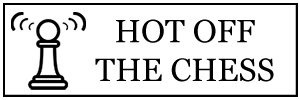
They say that the hardest thing to do in chess is to win a won game. In round six of the Isle of Man International tournament, Jeffery Xiong was to experience its frustration.
The American Grandmaster was paired against China’s Wang Hao, who was one of his co-leaders after round 5. Their split point should not be taken as any indication of their approach to this game. It was very much a fighting draw.
Playing White in the Open Catalan, Xiong negotiated the transition from middlegame to endgame well and liquidated the Queenside of the board. He obtained the best of the bishop vs knight endgame, with an extra pawn — two to his opponent’s one.
But this is where chess can be a total and utter bar-steward sometimes. In the position above, White has a completely winning setup in return for his hard work. However, material is nothing if it can’t be used. Technically, it is a draw.
This is because White can not win f5. Therefore, should he try anything, Black will simply exchange one pawn and give his knight for the other. White, though better, does not have control of the board, so can’t do anything about this. There followed 60.Kd5 (if your chess engine is anything like mine, it will give a big plus for Bd5 instead, but it is bonkers) and the players shook hands.
A hard fought game and Jeffery will probably feel a bit hard done by to not have come away with the full point. Another leader also got half a point in this round and that was Azerbaijan’s Arkadij Naiditsch, who fancied a day off and took a bye.
Unfortunately, the other leader after round five, India’s Abhijeet Gupta, did not have a good round. He would play black against America’s Hikaru Nakamura.
The game was an English Opening, which saw Nakamura take an advantage. As can be seen by the diagram, below, he was a pawn to the good and had the bishop pair — something that is not insignificant in this kind of position.
Personally, I would be most concerned by my knights if I was Black, here. They are beginning to look like spectators. Black really has to seek activity, and 19…d4 is a glaringly natural way to begin. Possible from here, is: 20.Na4 Qb5 21.Rf2 Nd5 22.Bxd4 Nxd4 23.Qxd4 Ne3 and Black is fighting.
Unfortunately for Abhijeet, he got a little sidetracked, here and plumped for an elaborate excursion with his Queen, beginning with 19…Qa7+. There followed 21.Kh1 Qe3 22.Rfd1 Qf2 23.Re1(e3 or Qe1 were also options) …Nb4 23.Nb5 Nc2.
And this seems to be the long term idea for Black. Perhaps Gupta did not quite look far enough, though because after Nakamura’s 24.Bd4, there is nothing better than 24…Nxd4 25.Nxd4 which leaves the Black Queen looking like a complete turnip.
This probably explains why Gupta opted for 24…Ne3 instead, which was no more pleasant. After 25.Bxe3, Qxe3 would lose a pawn to 26.Qxe3 Rxe3 27.Nxc7. Unfortunately for Gupta, his 25…Rxe3(?) lost even more.
Nakamura pounced with 26.Rf1 Qxe2 27.Qxe2 Rxe2 28.Nd4(!) and here we see that the Bf5 is doomed. Gupta resigned immediately. And with this, Hikaru Nakamura joined the lead with 5/6.
As did Poland’s Radoslaw Wojtaszek, who benefited from a rather serious slip up by his round six opponent, Rasmus Svanne of Germany. In the King’s Indian Attack, the players reached the following position.
White has just played 21.Qf3 and is better, (Black is just far too passive), but Black’s situation was about to get much worse. Advisable is probably 21…Ne8 when White actually has to be very careful.
The Ne5 is actually a little vulnerable to …f6. Should the knight go to c6, then Black would be rather happy after …Nxc6, bxc6 e5. The knight going anywhere else gives …e5 immediately. Unfortunately, Svane got the piece right but moved it to the wrong square — 21…Nfd7(?)
The thing about 21…Ne8, is that it is not all about releasing the f-pawn. The other important part is covering the d6-square. The absence of this part of the move is disaster as Wojtaszek illustrated — 22.Qxf7+(!!).
This move takes advantage of the black Queen being utterly over-worked. Not only is she guarding f7, but also d6. Obviously, 22…Qxf7 was forced, as was the recapture of the Queen, 23.Nxf7. Black is in complete disarray, here.
There followed 23…Rf8(obviously, …Kxf7, Nd6+) 24.Bxg7 Rxf7 25.Bb2 and not only was White a pawn up, but he had the much better position. Radoslaw converted very nicely and joined the lead.
And the leaders list was completed by Maxime Vachier-Lagrave, who rejoined after a couple of rounds out. He took a point from Rinat Jumabayev, defeating him with the black pieces. This was no top notch game from the Frenchman, however, his opponent from Kazakhstan was better until he erred.
Here, Vachier-Lagrave has just played 32…Rc2. Jumabayev has 33.b4 or even b3 in order to maintain his edge. Unfortunately for him, chess blindness struck and he blundered badly, with 33.f4(?)
This move hangs the b2-pawn, which Black captures with 33…Rxb2. The reason that this is playable, is that White’s Nd4 is pinned to the Rg1. So, if White captures on e5, (probably his best option), Black recaptures with …dxe5 and will recoup his piece.
Having been considerably better, Jumabayev found himself suddenly rather up against it. He immediately blundered again with 34.Nf1(??) which hung e4. The end came quickly, 0-1 in 36.
The exciting thing about this event, as well as seeing so many top players playing, is that it is so competitive. Even at this stage, there is still only a point separating the leaders from 37th place! Three rounds left!
Top Standings after Round 6
Vachier-Lagrave, Nakamura, Wojtaszek, Wang Hao, Naiditsch, Xiong — 5.0
Kramnik, Anand, Karjakin, Rapport, Adams, Artemiev, Jones, Sethurman, Parligras, Antipov, Gupta — 4.5

